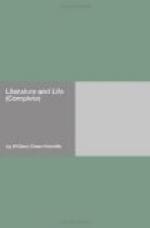One should, of course, say a good son, but long before this it had become impossible to think at all of Mme. Bernhardt’s Hamlet as a man, if it ever had been possible. She had traversed the bounds which tradition as well as nature has set, and violated the only condition upon which an actress may personate a man. This condition is that there shall be always a hint of comedy in the part, that the spectator shall know all the time that the actress is a woman, and that she shall confess herself such before the play is over; she shall be fascinating in the guise of a man only because she is so much more intensely a woman in it. Shakespeare had rather a fancy for women in men’s roles, which, as women’s roles in his time were always taken by pretty and clever boys, could be more naturally managed then than now. But when it came to the eclaircissement, and the pretty boys, who had been playing the parts of women disguised as men, had to own themselves women, the effect must have been confused if not weakened. If Mme. Bernhardt, in the necessity of doing something Shakespearean, had chosen to do Rosalind, or Viola, or Portia, she could have done it with all the modern advantages of women in men’s roles. These characters are, of course, “lighter motions bounded in a shallower brain” than the creation she aimed at; but she could at least have made much of them, and she does not make much of Hamlet.
III.
The strongest reason against any woman Hamlet is that it does violence to an ideal. Literature is not so rich in great imaginary masculine types that we can afford to have them transformed to women; and after seeing Mme. Bernhardt’s Hamlet no one can altogether liberate himself from the fancy that the Prince of Denmark was a girl of uncertain age, with crises of mannishness in which she did not seem quite a lady. Hamlet is in nothing more a man than in the things to which as a man he found himself unequal; for as a woman he would have been easily superior to them. If we could suppose him a woman as Mme. Bernhardt, in spite of herself, invites us to do, we could only suppose him to have solved his perplexities with the delightful precipitation of his putative sex. As the niece of a wicked uncle, who in that case would have had to be a wicked aunt, wedded to Hamlet’s father hard upon the murder of her mother, she would have made short work of her vengeance. No fine scruples would have delayed her; she would not have had a moment’s question whether she had not better kill herself; she would have out with her bare bodkin and ended the doubt by first passing it through her aunt’s breast.
To be sure, there would then have been no play of “Hamlet,” as we have it; but a Hamlet like that imagined, a frankly feminine Hamlet, Mme. Bernhardt could have rendered wonderfully. It is in attempting a masculine Hamlet that she transcends the imaginable and violates an ideal. It is not thinkable. After you have seen it done, you say, as Mr. Clemens is said to have said of bicycling: “Yes, I have seen it, but it’s impossible. It doesn’t stand to reason.”




